SG promotion
Paper brief
Data-driven services to increase the training outreach of the Centre via the promotion of free self-guided distance learning courses
1. Introduction
Data-driven services (DDS) refer to the use of data for evidence-based management and play a crucial role in the new operational model of the Centre.
In this context, ITCILO has developed an experiment focused on DDS with the scope of increasing the training outreach of the Centre and to investigate on DDS that “harness the data streams generated during past and ongoing service transaction processes to identify, by way of causal inference, individuals and institutions with a high demand and need for the Centre’s services.”
For this experiment ITCILO has promoted courses that are free, self-guided and online in order to make knowledge and learning materials accessible especially to those who do not have the resources or the ability to travel, and also for learners who need to take courses at their own pace.
Objectives of the experiment
- The overall objective of the experiment was to contribute to the achievement of the outcomes of the 2022–23 ITCILO Programme and Budget.
- The immediate objective of the experiment was to strengthen the capacity of the Technical Programmes of the Training Department to reach a larger number of people in the world of work with the right services through the right channel, here by experimenting with segment-specific promotional activities informed by marketing data analytics.
- The expected overall outcome of the experiment was an expanded participant universe.
- The expected immediate outcome of the experiment was a strengthened knowledge base for Technical Programmes of the Centre about (a) how to raise awareness about their distance learning services among potential beneficiaries and (b) how to convert leads into participants.
Scope
The scope of the experiment was limited to the promotion of free self-guided distance learning courses of the Centre. In the 2020–21 biennium, these free self-guided distance learning courses constituted about 60% of all participants reached with distance learning; they cover core ILO policy messages and are available 24/7 free of charge in official ILO languages - they thus constitute the most widely democratically accessible learning modality of the Centre. The focus on these free self-guided distance learning modules reflects the primary emphasis of the pilot on boosting outreach (not income) through data analytics.
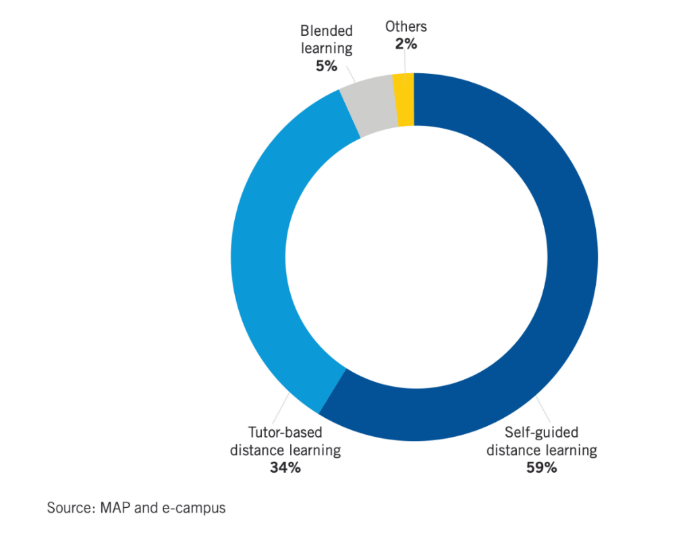
2. Research framework
Research questions
The experiment sought answers to three research questions (RQ):
- RQ 1: Can digital marketing increase uptake of free self-guided distance learning courses?
- RQ 2: Can targeted digital marketing aimed at potential learners with characteristics similar to prevalent profiles of past learners further increase uptake?
- RQ 3: Is there a causal link between growing numbers of learners in free self-guided distance learning courses and growing numbers in fee-based courses?
The dataset
The data warehouse of the Centre stores information from a number of ITCILO in-house databases plus data sources from the transactional and external environment. These databases furnish information about the beneficiaries of the distance learning offerings of the Centre as they move through the marketing funnel to convert into participants.
The marketing funnel for distance learners
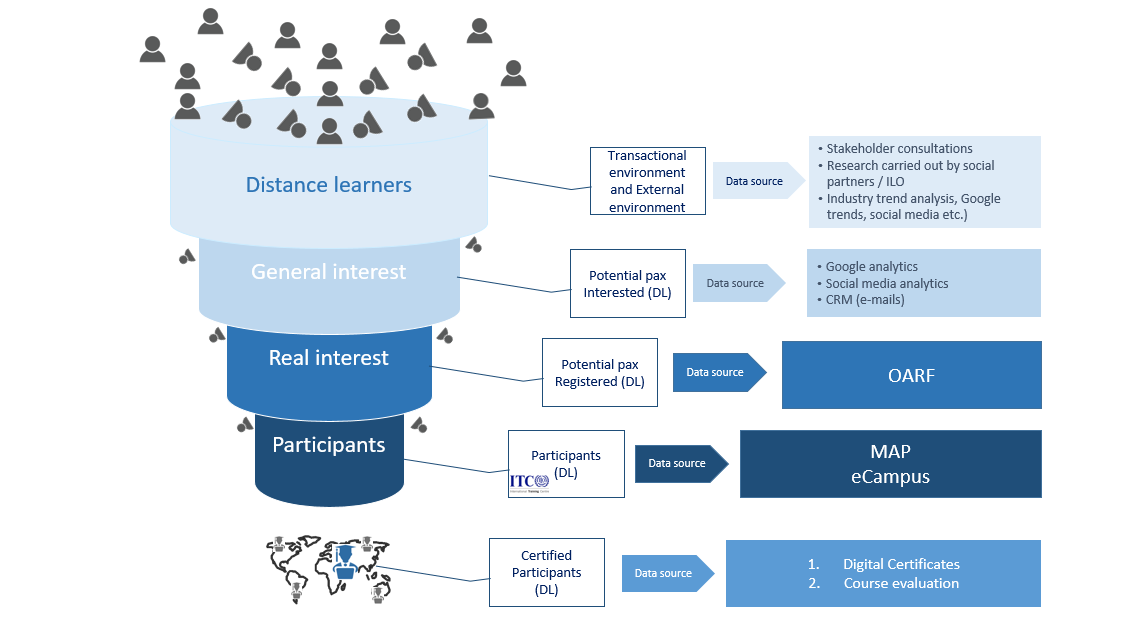
For the purposes of the experiment, all former participants in distance learning activities (both free and fee-based, and including tailor-made and open) offered by the Centre during the 2020–21 biennium were considered. Thus, a total of 124,863 distance learners enrolled were in theory eligible for analysis and subsequent outreach campaigns, including 73,406 participants in free self-guided distance learning courses and 51,457 participants in fee-based distance learning courses.
In addition to internal databases, also external databases have been analysed such as Google Analytics, Facebook Analytics.
Key performance indicators
In order to answer the research questions, key performance indicators (KPIs) and relative targets have been set to measure the results of the experiment. In particular:
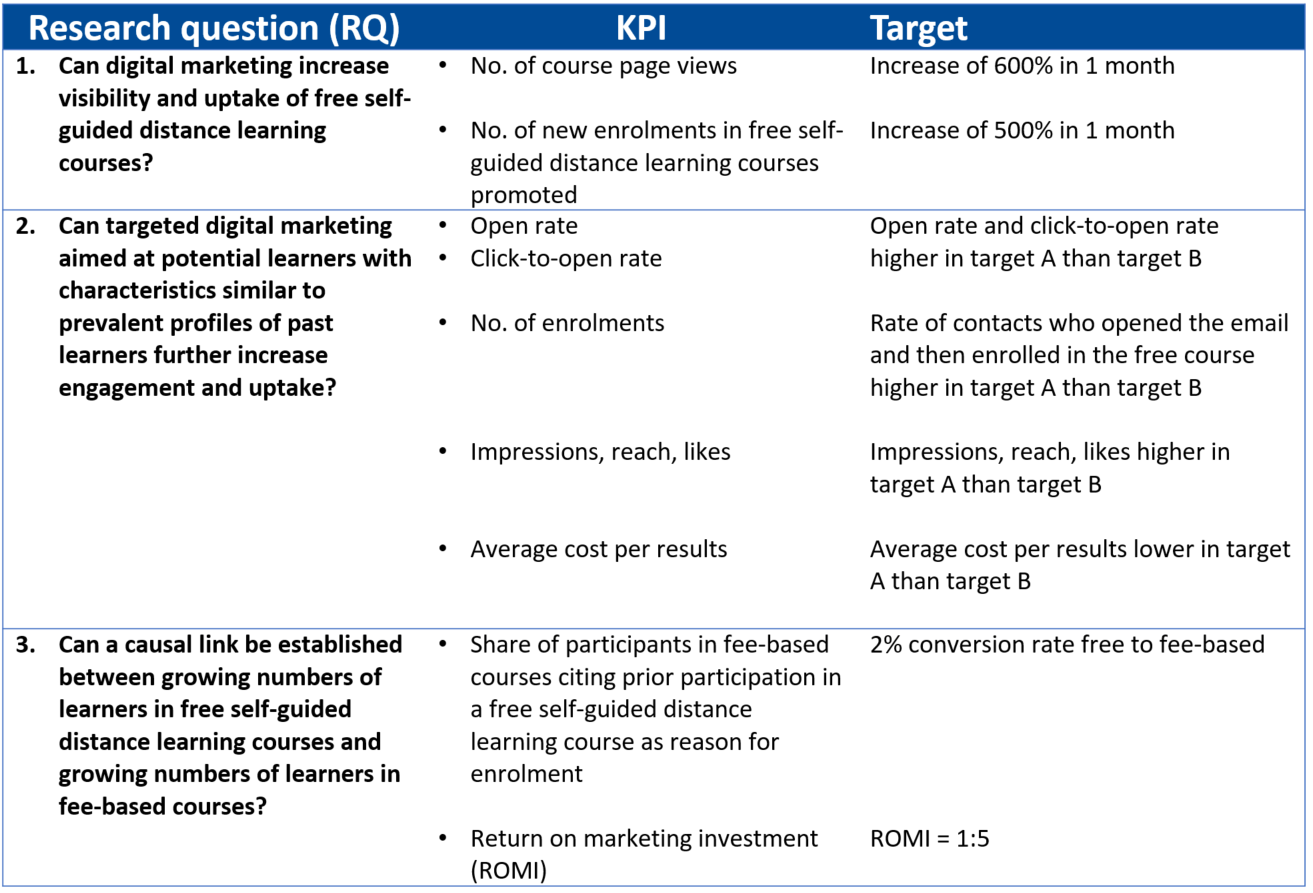
Glossary
- Open Rate: the percentage of email recipients who open a given email.
- Click-to-open rate: the click-to-open rate (CTOR) compares the number of unique clicks to unique opens. This number indicates how effectively the email message, design and content performed, and whether it created enough interest in the recipient to take action (Source: https://www.campaignmonitor.com).
- Impression: number of times content is displayed.
- Reach: number of people who see the content.
- Likes: number of post likes.
- Average cost per results: calculated by dividing the total amount spent by the number of results (for example, reach, clicks, conversions, video views).
- ROMI: Return on marketing investment
The course sample
At the time of the experiment, ITCILO offered more than 30 free self-guided distance learning courses (depending on the period of the year). The courses are standardized in terms of structure, quality and overall characteristics. A typical free self-guided distance learning course will comprise a series of short modules with videos, slides, quizzes and a final test. Participants who have successfully completed the test can download a certificate of completion as a micro-credential of their learning achievement. The minimum duration of a free self-guided distance learning course is one hour (equal to the smallest unit of learning distinguished in any learning activity of the Centre). For more information on each free self-guided distance learning course, refer to the online catalogue of the Centre.
For the purpose of the experiment, the Centre chose three free self-guided distance learning courses from the portfolio:
- Business and Decent Work developed by the Sustainable Enterprises and Economies Programme (SEE) https://www.itcilo.org/courses/business-and-decent-work
- Introduction to International Labour Standards (ILS) developed by the International Labour Standards and Gender Equality Promotion Programme (ILSGEN) https://www.itcilo.org/courses/introduction-international-labour-standards
- Introduction to Project Cycle Management developed by the Organizational Development and Project Management Services Programme (ODPS). https://www.itcilo.org/courses/introduction-project-cycle-management
The first and second courses rank among the most successful self-guided distance learning activities in the 2020–21 biennium in terms of number of enrolments and, given the data availability, were chosen to verify whether their flagship status could be further boosted by targeted digital marketing.
The third course was newly introduced in 2022 and launched during this experiment, and was chosen to benchmark results for flagship products against results for new and unknown service products. Another consideration was to choose only free-self guided distance learning courses on topics also covered in fee-based courses in order to shed further light on conversion rates from free to fee-based (the third research questions refers).
The top 10 free self-guided distance learning courses by number of enrolments (2021–2021)
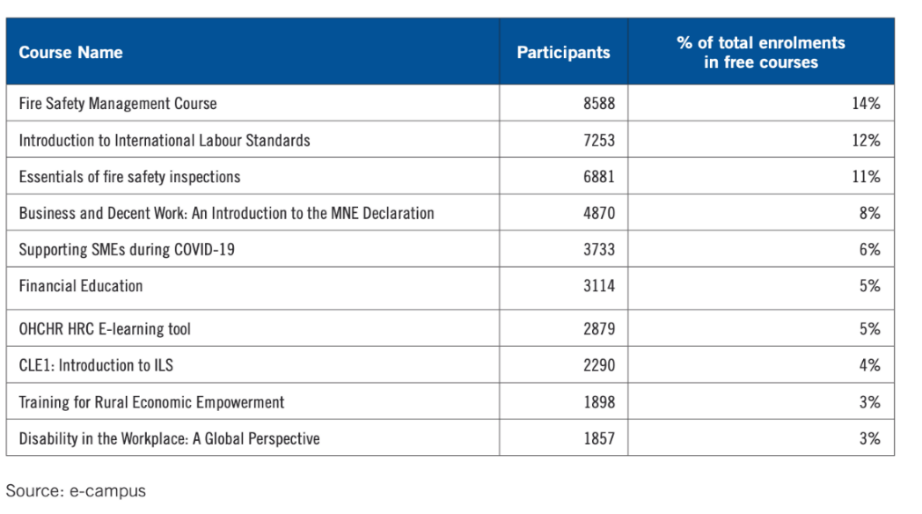
The personae
As part of the experiment, the data set was filtered for profiles of prevalent participant groups. Some of the characteristics of these prevalent participants were then used to construct personae to test the results of targeted outreach campaigns.
The data analysis revealed that, statistically speaking, the ITCILO 2020–21 former participants in free self-guided distance learning courses were likely to have been
- young (25 to 34)
- male
- originating from the Asia and Pacific region (in particular: India, Pakistan and Bangladesh)
- working in training/academic institutions, enterprises or NGOs.
In order to test whether this general profile of free self-guided course participants could be representative for all, participants were analysed by subject area, to adjust for the over-prevalence of participants enrolled in OSH courses, in particular in the Fire Safety course and the Occupational Safety and Health courses (which together accounted for around 25 per cent of the total participants in free self-guided courses during the 2020–21 biennium).
Breakdown of the universe of distance learners by region of origin 2020–21 biennium (free versus fee-based)
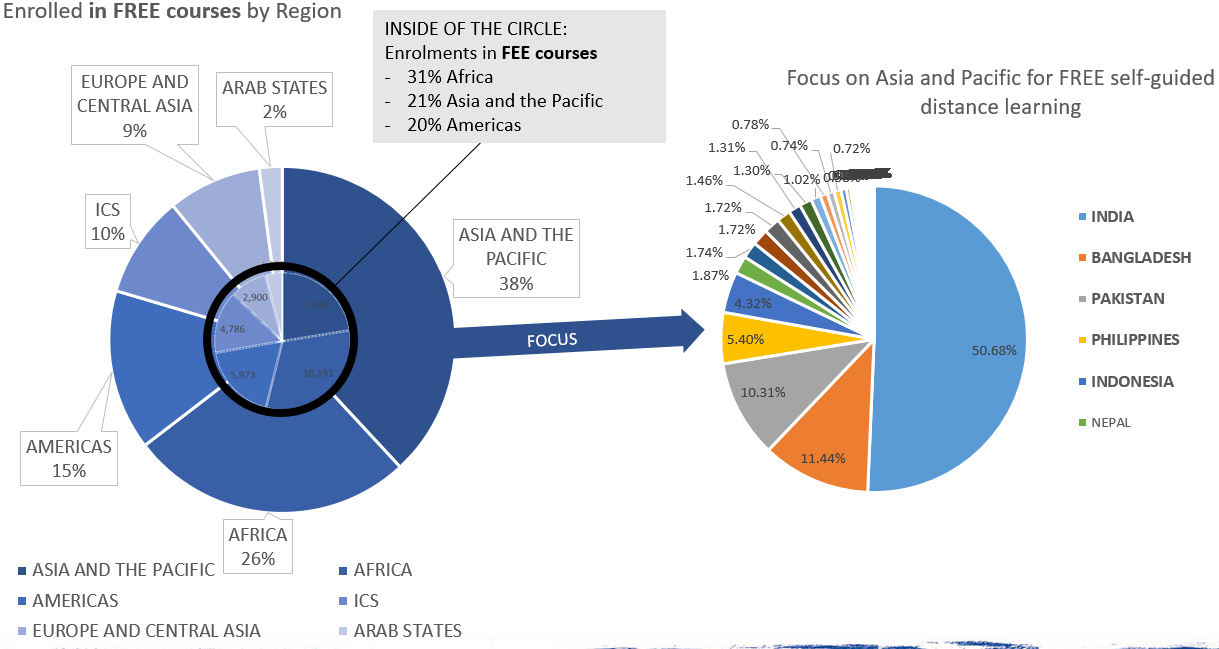
When the analysis of the free self-guided courses was subsequently further refined, it was observed that the dominant age cohort remained the same across all courses (in other words, that distance learners are always more likely to belong to the age cohort 25–34 years) while region of origin and gender of the learners varied significantly according to course topic and according to the question of whether the course was offered for free or was fee-based. In the latter case, somewhat counter-intuitive to expectation, women were far more likely to enrol in fee-based courses (36 per cent of all enrolments in free self-guided courses compared to 49 per cent in fee-based distance learning courses). It is also interesting to note that women outnumbered men in the age cohorts 18-24 years and 25-34 years.
Breakdown of the universe of distance learners by age and gender 2020–21 biennium (free versus fee-based)
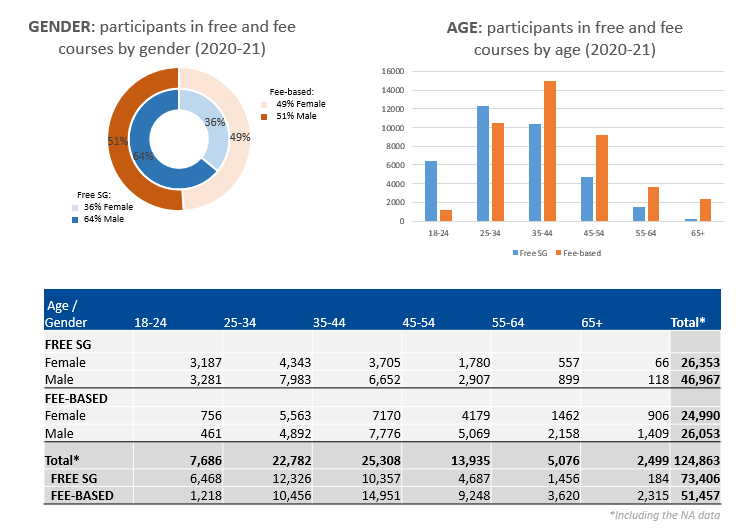
Based on this analysis of the profile of past participants, it was decided to use gender and region of origin as segmentation variables to construct personae of potential leads. More in particular, three personae were developed for the experiment:
Implementation roadmap

The preparatory stages of the experiment, including concept design, data preparation, data analysis and discussions, took place in May and June. The actual promotional campaigns were run from July to September through two different digital marketing channels:
- The CRM campaigns (by email) were launched in three waves, one wave per course on 30 June (Business and Decent Work), 14 July (ILS) and 18 July (Project Cycle Management). Accordingly, the effects of these campaigns on course page views and enrolment became visible in different calendar weeks.
- The social media campaigns via Facebook Ads were implemented again in three waves, one for each course. To test good practices, the Introduction to ILS and Business and Decent work courses were promoted in English and also in Spanish and French respectively. The Introduction to PCM course on the other hand, being available only in English, was exclusively promoted in English. The duration of each campaign was one week.
Each wave in turn was divided by target audience: target A, based on the personae identified in the analysis (gender and region) and target B as the control group, including the rest of the world.
3. Findings
RQ 1: Can digital marketing increase uptake of free self-guided distance learning courses?
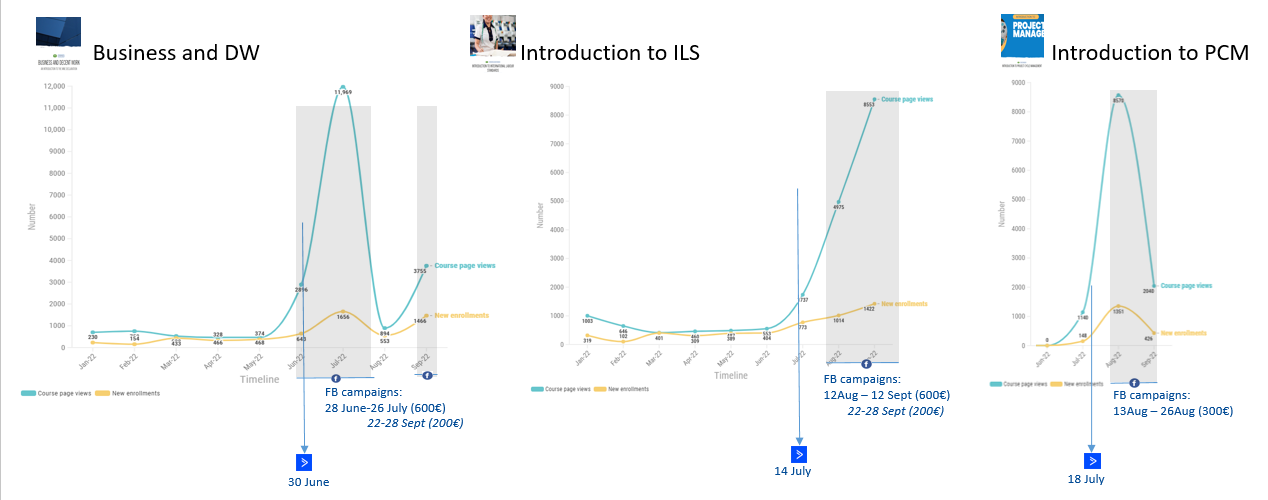
The findings of the experiment imply that digital marketing can improve uptake of free self-guided distance learning courses. Course page views and subsequent enrolments significantly increased during the experiment on the back of a social media campaign and email marketing activities.
Page views and enrolments of the free SG distance learning courses promoted
Flow of the three free SG distance learning courses promoted
Daily enrolments for each of the three free SG distance learning courses
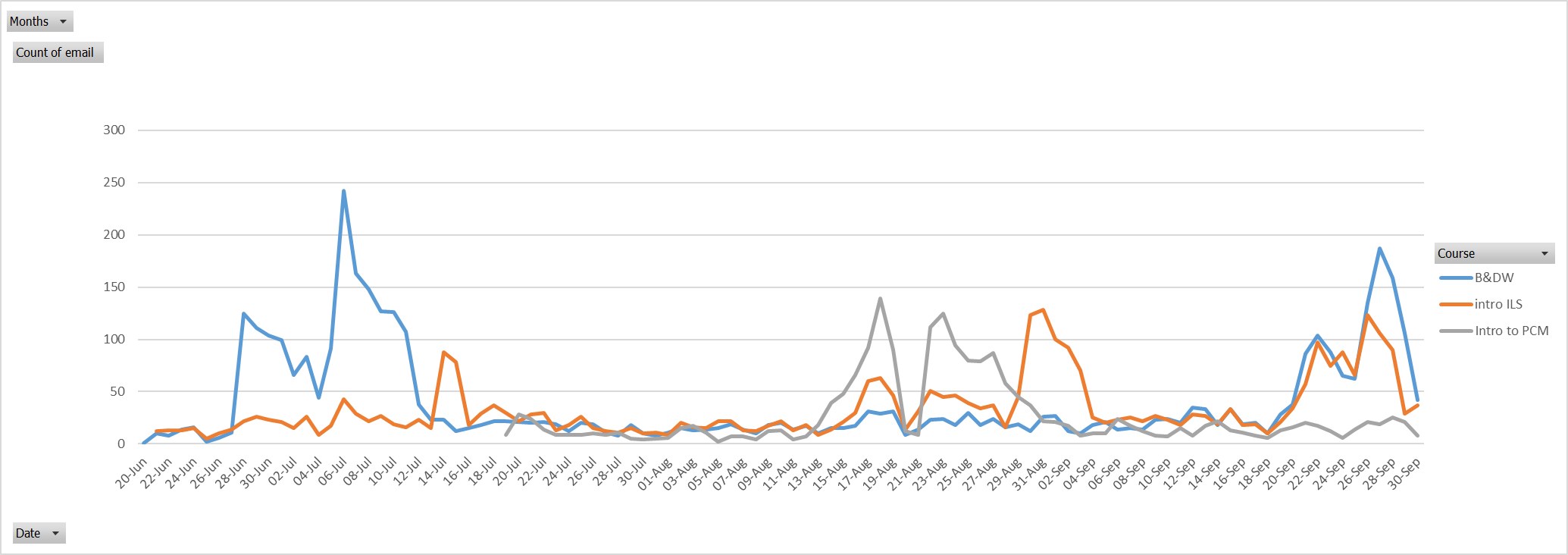
Results of the promotion
RQ 2: Can targeted digital marketing aimed at potential learners with characteristics similar to prevalent profiles of past learners further increase uptake?
Focus on CRM
As part of the CRM-supported course-specific email campaigns, the Centre also tested whether targeted emails would result in higher response rates. Each campaign therefore had two groups of recipients:
- Target A: potential participants with characteristics conforming to the persona of the prevalent group of participants in earlier distance learning courses of the Centre;
- Target B: control group, here all other contacts in the respective database
Campaigns targeted at potential distance learners with profiles similar to prevalent groups of distance learners from past learning activities on the same topic can significantly further drive response rates in the case of email marketing.

The campaign results show that potential participants with a persona resembling the prevalent profile of past participants were significantly more likely not only to open the email and click on the link but also to enrol in the course. More specifically, open rate, click-to-open rate and click rate was always higher for target A (target A 36%, 36% and 13% respectively over target B 27%, 29% and 8% respectively). Furthermore, for target A, the rates in all three campaigns were in all cases above the benchmark for a good response rate in the education sector.
Focus on Facebook Ads
In turn, where Facebook Ads campaigns are concerned, absolute numbers of people reached are higher when campaigns are not tailored to personae due to the sheer scale of the global network of Facebook users. This also means that Facebook Ads campaigns are most effective when targeting interests, and thus can be used to reach a new target audience worldwide, while profile-targeted emails are more effective at converting potential leads. For best results, the two channels could be combined.

As regards the question of whether personae of prevalent groups of former participants can serve as a blueprint for targeting messages at potential leads, it is important to note that the profiles diverge primarily by subject area. Therefore, interest in a given topic due to professional background seems a strong denominator of inclination to enrol in a distance learning activity.
Not surprisingly, language of instruction can tilt enrolments in given regions even though English seems the preferred medium of instruction across the beneficiary universe. Interestingly, women were as likely as men to enrol in fee-based courses, somewhat refuting popular assumptions about their heightened vulnerability when accessing the digital learning highway.
RQ 3: Is there a causal link between growing numbers of learners in free self-guided distance learning courses and growing numbers in fee-based courses?
To check for a causal link between growing numbers of learners in free self-guided distance learning courses and growing numbers of learners in fee-based courses, the experiment focused on participants who had enrolled first in a free self-guided course and later in a fee-based distance learning course while the promotional campaigns were underway. A total number of 233 participants fell into this group, out of which 132 participants had converted from free to fee-based (in other words, they had enrolled in the free self-guided distance learning course first).
To establish causality between enrolment in a free self-guided distance learning course and enrolment in a fee-based distance learning course, an online survey covering the 132 potential freemium participants was conducted. 41 participants responded, out of which 17 stated that they had applied as a result of email promotion and 7 stated they had applied as a result of the Facebook campaign. 28 respondents confirmed that they had converted from free to fee-based after testing the self-guided distance learning course; on a side note, 13 respondents had enrolled in a free course after having completed a fee-based course first, implying that conversion can go both ways.
The experiment points towards a causal link between growing numbers of learners in free self-guided distance learning courses and growing numbers in fee-based courses. Generally speaking, the absolute number of enrolments in fee-based courses increases on the back of growing numbers in free self-guided distance learning courses, as a certain proportion are likely to continue their learning journeys provided they had a quality learning experience. Notably, causality can play out both ways, with trainees converting from free to fee-based and vice-versa. The conversion rates tend to increase when a link to a related learning activity is added at the end of a given learning activity, ideally combined with an incentive to continue along a multi-step learning journey (like the prospect of attaining a diploma).
4. Conclusions
1. Digital marketing
Digital marketing can improve uptake of free self-guided distance learning courses.
Course page views and subsequent enrolments significantly increased during the experiment on the back of a social media campaign and email marketing activities.
2. Email promotion
For email promotion, campaigns targeted at potential distance learners with profiles similar to prevalent groups of distance learners in past learning activities can significantly further drive up response rates.
3. Facebook Ads
Where Facebook Ads campaigns are concerned, absolute numbers of people reached are higher when campaigns are not tailored to personae due to the sheer scale of the global network of Facebook users. This also means that Facebook Ads campaigns might be more effective at raising general awareness and reaching new audiences about a distance learning offering while targeted emails are more effective at converting potential leads. For best results, the two channels could be combined.
4. Target personae of prevalent group
As regards the question of whether personae of prevalent groups of former participants can serve as a blueprint for targeting messages at potential leads, age cohort (25–44 years) combined with interest in a given topic due to professional background seems a strong denominator of inclination to enrol in a distance learning activity while region of origin and gender are far less reliable predictors. Not surprisingly, language of instruction can tilt enrolments in given regions even though English seems the preferred medium of instruction across the beneficiary universe. Interestingly, women were as likely as men to enrol in fee-based courses, somewhat refuting popular assumptions about their heightened vulnerability when accessing the digital learning highway.
5. Learners in both free and fee courses
The experiment points towards a causal link between growing numbers of learners in free self-guided distance learning courses and growing numbers in fee-based courses. Generally speaking, the absolute number of enrolments in fee-based courses increases on the back of growing numbers in free self-guided distance learning courses, as a certain proportion are likely to continue their learning journeys provided they had a quality learning experience.
6. Learning journey
Notably, causality can play out both ways, with trainees converting from free to fee-based and vice-versa. The conversion rates tend to increase when a link to a related learning activity is added at the end of a given learning activity, ideally combined with an incentive to continue along a multi-step learning journey (like the prospect of attaining a diploma).
5. Recommendations
For Training Programmes
As a follow-up to the experiment, it is recommended that Technical Programmes:
- Systematically promote distance learning offerings to stimulate service uptake in unit-level areas of expertise.
- Promote free self-guided distance learning activities as entry-level services that lead towards follow-up enrolments.
- Incentivize follow-up enrolments by bundling services together as learning journeys.
- Use social media ads to boost Customer Relationship Management (CRM) and increase the universe of contacts including from vulnerable groups.
- Use Facebook campaigns to widely increase visibility, engagement and product awareness across the beneficiary universe and expand the number of active contacts in the central CRM database.
- Focus on targeted email campaigns to follow-up on these leads.
For the Office of the Director of Training
It is furthermore recommended that the Office of the Director of Training:
- At regular intervals, promote all free self-guided distance learning courses to the beneficiary universe as part of Facebook campaigns.
- In addition, draw on the central CRM database to launch feature campaigns promoting course packages linked to themes prioritized by the ILO.
- Carry out follow-up experiments to further investigate channels for increasing training outreach among core constituents and target groups with known vulnerabilities.
- Support Technical Programmes to develop additional free flagship self-guided distance learning courses and to increase awareness of the profile of participants and appropriate outreach actions.
Original paper by:
